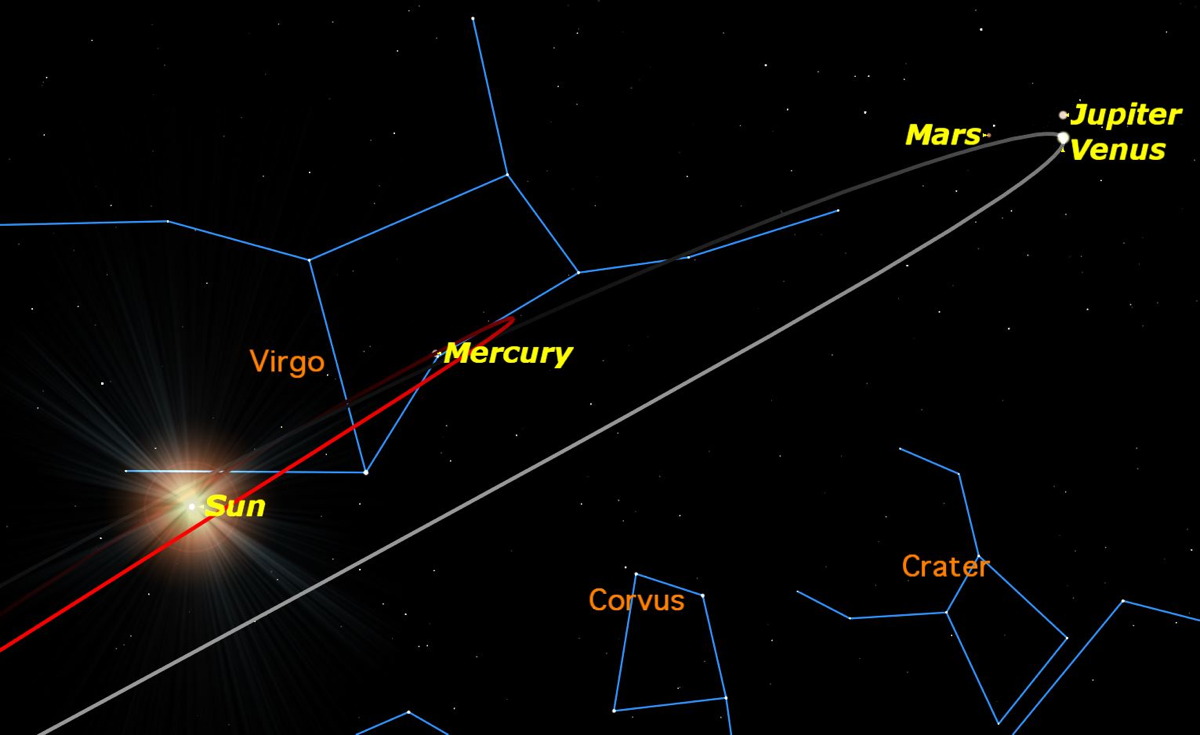Brilliant Venus to Join Jupiter and Mars in Pre-Dawn Sky Monday: How To See It

Venus has been dominating the morning sky for the past two months, and Monday (Oct. 26), it will form a vivid tableau with Jupiter and Mars as it reaches its farthest point from the sun.
In the early morning of Oct. 26, Venus will reach its greatest elongation west — 46 degrees west of the sun, or to the right in the sky. (Directions in the sky are the reverse of directions on the surface of the Earth, so west is to the right in the sky if you live in the Northern Hemisphere.)
The inner planets, Mercury and Venus, never stray far from the sun in Earth's sky. Mercury was at its greatest elongation west, 18 degrees from the sun, last Friday (Oct. 16), and is now moving back toward the sun. Venus is still moving away from the sun, but will pause and reverse directions on Oct. 26. Mars and Jupiter, with orbits outside that of Earth, both appear to be moving steadily westward relative to the sun. [October Skywatching: Eclipses, a Meteor Shower and More]
As a result, Venus and Jupiter will pass very close to each other — within 1.1 degrees — on Monday.
Venus is by far the brightest of the two, at magnitude minus 4.6, while Jupiter is nearly three magnitudes fainter, at magnitude minus 1.8. Mars, which is also nearby in the sky, is a distant third in brightness, at magnitude 1.7 — more than three magnitudes fainter than Jupiter and six magnitudes fainter than Venus. (For comparison, the darkest object the human eye can see is magnitude 6.)
This close conjunction of Venus, Jupiter and Mars is best observed with the naked eye or binoculars. In a telescope, Venus will appear as a perfect miniature quarter moon, because at its greatest elongation, it is lit by the sun exactly from its left side. It appears 24 arc seconds in diameter, slightly smaller than Jupiter's 33 arc seconds but much larger than Mars' mere 4 arc seconds. A full moon, for contrast, is about 1,800 arc seconds wide.
Venus appears brightest because it is close to both the sun and the Earth. Jupiter is much larger in actual diameter — but it's far from the sun, so it's lit dimly. Mars — in between Venus and Jupiter in its distance from the sun, and small in size — is currently very far from Earth, so it appears even dimmer.
Get the Space.com Newsletter
Breaking space news, the latest updates on rocket launches, skywatching events and more!
To put them into perspective, even though they're grouped closely together in our sky, the three planets vary greatly in distance from the Earth. Venus is closest, at 0.69 astronomical units (AU) on that particular day — 0.69 times the average distance between Earth and the sun. Mars is next, at 2.2 AU, and Jupiter is the farthest of the three, at 6.0 AU — nearly 10 times farther than Venus.
Many photographers have been taking advantage of the close approach of these three planets to capture them in the dawn sky, though the different brightnesses present a challenge in exposure. As always, we welcome your pictures of this beautiful event.
Editor's note: If you have an amazing night-sky photo you'd like to share for a possible story or image gallery, please contact managing editor Tariq Malik at spacephotos@space.com.
This article was provided to Space.com by Simulation Curriculum, the leader in space science curriculum solutions and the makers of Starry Night and SkySafari. Follow Starry Night on Twitter @StarryNightEdu. Follow us @Spacedotcom, Facebook and Google+. Original article on SPACE.com.
Join our Space Forums to keep talking space on the latest missions, night sky and more! And if you have a news tip, correction or comment, let us know at: community@space.com.

Geoff Gaherty was Space.com's Night Sky columnist and in partnership with Starry Night software and a dedicated amateur astronomer who sought to share the wonders of the night sky with the world. Based in Canada, Geoff studied mathematics and physics at McGill University and earned a Ph.D. in anthropology from the University of Toronto, all while pursuing a passion for the night sky and serving as an astronomy communicator. He credited a partial solar eclipse observed in 1946 (at age 5) and his 1957 sighting of the Comet Arend-Roland as a teenager for sparking his interest in amateur astronomy. In 2008, Geoff won the Chant Medal from the Royal Astronomical Society of Canada, an award given to a Canadian amateur astronomer in recognition of their lifetime achievements. Sadly, Geoff passed away July 7, 2016 due to complications from a kidney transplant, but his legacy continues at Starry Night.



